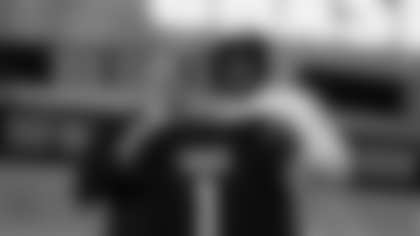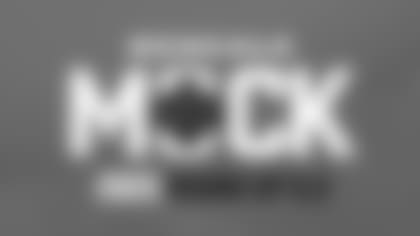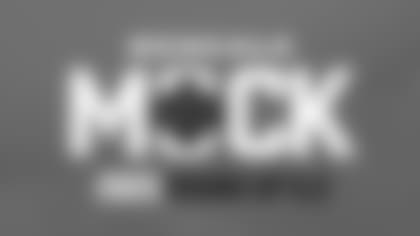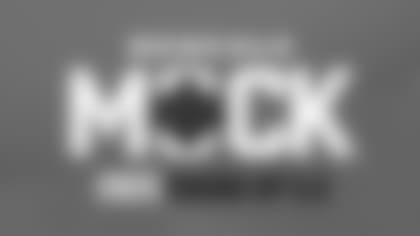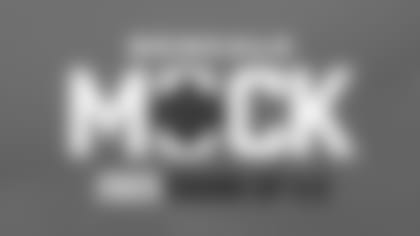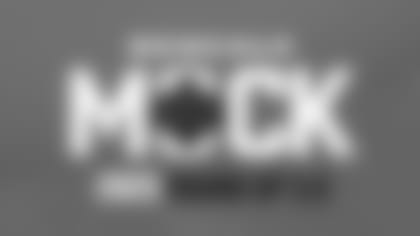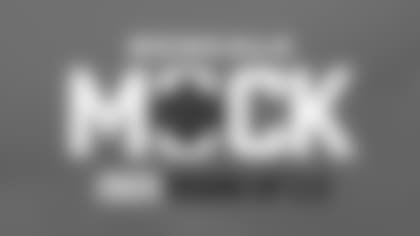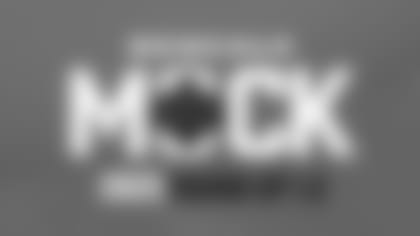Like Ryan Fitzpatrick and Pat McInally, George Santayana came out of Harvard. He didn't have Fitzpatrick's arm or McInally's leg, but the late philosopher and poet no doubt would have given both a run in the Wonderlic test.
Santayana is credited with the line,"Those who cannot remember the past are condemned to repeat it." Which is a good place to start with the NFL Draft on Tuesday, the day the scouting combine was put to rest with the workout for defensive backs.
Let's see how the past can aid the Bengals as they come back to Cincinnati to sift through combine date:
CORNERBACKS: Go back to 2004.
When Dennis Weathersby is in a career-ending car accident a week before the draft, the Bengals find themselves in a desperate need for a third cornerback.
Florida's Keiwan Ratliff is smart and productive with a quarterback's eyes and hands. But he can't run very well. Mid-second round is too high for him, but the Bengals aren't going to get anyone that can come in and play if they wait another round.
Ratliff becomes a solid nickel player, but more than that is needed with the 49th pick.
To be fair, the Weathersby accident put the Bengals in a tough spot. But it is a teachable moment.
The Bengals need a cornerback this year and are faced with the prospect of not having a player worthy of No. 17 or No. 21. Nebraska's Alfonzo Dennard running only a 4.55-second 40 on Tuesday seems to be the reminder about not reaching. If Dennard is the 33rd player on the board, don't make him the 21st pick because you need him to be.
GUARDS: Go back to 2006.
It is the second round and the Bengals have just had their hearts broken by the Cowboys taking Notre Dame tight end Anthony Fasano at No. 53. Now at 55, some of the players available are LSU left tackle Andrew Whitworth and Miami return specialist Devin Hester.
But no one knows what position Hester can play (wide receiver or cornerback?). And while Whitworth is a fine player, the Bengals expect to re-sign one of the NFL's top left tackles, Levi Jones, to a long-term deal before the season.
Although the pick isn't popular because they already have Jones and guard Eric Steinbach on the left side, the Bengals go with Whitworth because of intelligence, versatility and reliability. Plus the Bengals know he'll also be, at the very least, a terrific left guard for 10 years if they lose Steinbach in free agency the next year.
It turns out to be one of Cincinnati's more astute picks. Jones gets hurt in 2007 and 2008, and by 2009 Whitworth is playing Pro Bowl-caliber left tackle as well as becoming one of the team's locker-room leaders.
Another teachable moment. Never turn down a 10-year lineman on either side of the ball. No matter how many you think you have. Especially in the AFC North.
The Bengals could be faced with this in the first round if the draft's two top guards are there. Stanford's David DeCastro and Georgia's Cordy Glenn won't get the tongues wagging like Alabama running back Trent Richardson, North Alabama cornerback Janoris Jenkins, or Notre Dame wide receiver Michael Floyd. Guards may not sell tickets, but the guys they protect do.
RUNNING BACKS: None of the top five rushers in Bengals history are first-rounders.
No. 1 Corey Dillon and No. 4 Pete Johnson were second-rounders. Rudi Johnson was a fourth. James Brooks came via trade and Cedric Benson arrived from the waiver wire.
That's the trend now in the league, too, as the NFL Network's Mike Mayock pointed out at the combine.
"If you're not Adrian Peterson you probably shouldn't be a top five or top 10 running back; and even Darren McFadden, who has had all the injury problems," Mayock said of his research dating to the 2007 draft.
"If you go back to every class to Adrian Peterson, you can't make a case for a top 10 running back. And there's so many good running backs you can get later in the first. Or the year (2009, Lesean) McCoy and those guys came out there were three or four first-round picks, none of who panned out and McCoy was the 53rd or 54th pick in the draft. Shonn Greene was the first pick in the third round. You just keep going down the draft at the running back position and go, 'Wow.' Why not go down a little bit further and get somebody worth two backs for the price of one?"
It makes one wonder if the Bengals would even draft Richardson if the draft's one first-round back were there. Or if they would trade down if somebody else wanted him badly enough.
Bengals offensive coordinator Jay Gruden is on record saying the Bengals can get a good running back at some point and history says he's right.
What is going to be interesting is that Gruden seems to have a different taste than what has usually passed for the typical Bengals bell cow. Except for Brooks, they've all been at least 5-10, 220ish pounds. All of them played in college's biggest leagues, ranging from the SEC (Brooks, Rudi Johnson), the Pac 10 (Dillon), the Big Ten (Pete Johnson) and Big 12 (Benson).
But guys like 5-9 Doug Martin of Boise State, 5-9, 205-pound David Wilson of Virginia Tech, and 5-9, 200-pound Isaiah Pead of Cincinnati are raising eyebrows in this draft.
The one thing that seems to be holding is that the Bengals know by their own history they don't have to reach for a back.
MORE CORNERBACK: Go back to 2005.
It is the 48th pick. It is the second round and the Bengals know the big name on the board, Georgia middle linebacker Odell Thurman, is a first-round player with gamebreaking Pro Bowl potential. They also know he has enough off-field baggage to cause five hernia procedures.
But the Bengals also know how they will drastically upgrade their defense by picking Thurman after selecting his college teammate in the first round, pass rusher David Pollack.
It is the classic Draft Day gamble and the Bengals lose. Thurman has an NFL Defensive Rookie of the Year season (Shawne Merriman wins it), but he never plays another snap because his off-field problems overwhelm him.
(Even then ESPN was showing its penchant for leaping on and off bandwagons. After the second round the network was saying the Bengals had one of the day's three best drafts.)
A similar dilemma may face the Bengals in the first round this year with Jenkins. He's clearly a first-round talent at a spot where they need depth. But failed drug tests as well as three arrests sparked his transfer from Florida.
The seven picks after Thurman weren't exactly Pro Bowlers. Marcus Johnson? Ron Bartell? Khalif Barnes? But the eighth pick shows the draft is just like life. Fate. Luck. Fortune.
The 56th selection was cornerback Darrent Williams, a superb player shot and killed at age 24 hours after his second season ended.
DEFENSIVE TACKLE: Go back to 1994.
Ohio State defensive tackle Dan Wilkinson absolutely tears up his workout. The only thing missing is his cape and phone booth. If the Bengals don't take him with the draft's No. 1 pick, their defense will be sentenced to an eternity of doom.
Lost in the hype is that Wilkinson has played just 22 games in college and there are concerns about his down-to-down intensity.
So the Bengals take him and the guy picked right behind him, running back Marshall Faulk, goes to the Hall of Fame with plenty of college tape that has his 62 career touchdowns at San Diego State.
OK, maybe anybody would have taken Wilkinson that year. But here's a cautionary tale from ProFootballTalk.com on Tuesday:
"Memphis nose tackle Dontari Poe absolutely blew up the Scouting Combine. He was hand-timed as fast as 4.87 in the 40-yard dash at 6-4 and 346 pounds. He led every player invited to Indianapolis with 44 reps on the 225-pound bench press … . CBS Sports's Bruce Feldman interviewed one veteran college offensive line coach who game-planned against Poe: 'He's probably the best talent I've seen in several years. ... He took plays off and wasn't a great effort guy, but he is a freakish talent.' "
Poe also played 30 games before he had his 4.87 seconds of glory.
You figure those tapes are going to be dissected.
TRADING UP: Go back to 2010.
After taking Oklahoma tight end Jermaine Gresham with their first-round pick to address their biggest need on offense, the Bengals are now trying to attack their biggest need on defense. Can they trade back up into the second round for USC big-play safety Taylor Mays?
If they did, they couldn't find a match. Teams either didn't want to do it or wanted too much.
If the Bengals did pursue the trade, it would have cost them, at one time or another, left end Carlos Dunlap, wide receiver Jordan Shipley, or defensive tackle Geno Atkins. Those three are currently three of the big reasons the Bengals are seen as the AFC's top young and emerging team. Not only that, they still got Mays in a trade after his rookie year with the 49ers ended in disappointment.
Another example of how sticking to the board can't hurt.
So if the Alabama kids start dropping, such as Richardson, safety Mark Barron, cornerback Dre Kirkpatrick, falling to 13, 14, 15, be careful about screaming for a trade up.


